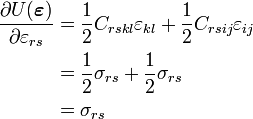Introduction to Elasticity/Constitutive example 3
< Introduction to ElasticityExample 3
Given: The strain energy density for a material undergoing small strain
Show: For linear elastic deformations and small strains,
Solution
If the strain energy density is given by equation (1), then (for linear elastic materials) the stress and strain can be related using
We will show that equation (2) is equivalent to equation (3). We start off with equation (2) and work backward.
For linear elastic materials,
Substituting equation (5) into equation (4), we get,
Recall that, for a second order tensor  ,
,
and that for a fourth order rensor  (substitution rule),
(substitution rule),
Differentiating equation (6) with respect to  ,
we have,
,
we have,
Using the symmetry of the stiffness tensor, we have,
Therefore,
which is the same as equation (3). Hence shown.
This article is issued from Wikiversity - version of the Monday, February 01, 2016. The text is available under the Creative Commons Attribution/Share Alike but additional terms may apply for the media files.










